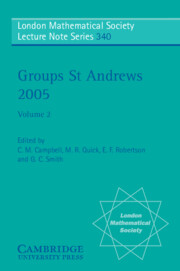Book contents
- Frontmatter
- Contents
- Introduction
- 1 Groups and semigroups: connections and contrasts
- 2 Toward the classification of s-arc transitive graphs
- 3 Non-cancellation group computation for some finitely generated nilpotent groups
- 4 Permutation and quasi-permutation representations of the Chevalley groups
- 5 The shape of solvable groups with odd order
- 6 Embedding in finitely presented lattice-ordered groups: explicit presentations for constructions
- 7 A note on abelian subgroups of p-groups
- 8 On kernel flatness
- 9 On proofs in finitely presented groups
- 10 Computing with 4-Engel groups
- 11 On the size of the commutator subgroup in finite groups
- 12 Groups of infinite matrices
- 13 Triply factorised groups and nearrings
- 14 On the space of cyclic trigonal Riemann surfaces of genus 4
- 15 On simple Kn-groups for n = 5, 6
- 16 Products of Sylow subgroups and the solvable radical
- 17 On commutators in groups
- 18 Inequalities for the Baer invariant of finite groups
- 19 Automorphisms with centralizers of small rank
- 20 2-signalizers and normalizers of Sylow 2-subgroups in finite simple groups
- 21 On properties of abnormal and pronormal subgroups in some infinite groups
- 22 P-localizing group extensions
- 23 On the n-covers of exceptional groups of Lie type
- 24 Positively discriminating groups
- 25 Automorphism groups of some chemical graphs
- 26 On c-normal subgroups of some classes of finite groups
- 27 Fong characters and their fields of values
- 28 Arithmetical properties of finite groups
- 29 On prefrattini subgroups of finite groups: a survey
- 30 Frattini extensions and class field theory
- 31 The nilpotency class of groups with fixed point free automorphisms of prime order
9 - On proofs in finitely presented groups
Published online by Cambridge University Press: 20 April 2010
- Frontmatter
- Contents
- Introduction
- 1 Groups and semigroups: connections and contrasts
- 2 Toward the classification of s-arc transitive graphs
- 3 Non-cancellation group computation for some finitely generated nilpotent groups
- 4 Permutation and quasi-permutation representations of the Chevalley groups
- 5 The shape of solvable groups with odd order
- 6 Embedding in finitely presented lattice-ordered groups: explicit presentations for constructions
- 7 A note on abelian subgroups of p-groups
- 8 On kernel flatness
- 9 On proofs in finitely presented groups
- 10 Computing with 4-Engel groups
- 11 On the size of the commutator subgroup in finite groups
- 12 Groups of infinite matrices
- 13 Triply factorised groups and nearrings
- 14 On the space of cyclic trigonal Riemann surfaces of genus 4
- 15 On simple Kn-groups for n = 5, 6
- 16 Products of Sylow subgroups and the solvable radical
- 17 On commutators in groups
- 18 Inequalities for the Baer invariant of finite groups
- 19 Automorphisms with centralizers of small rank
- 20 2-signalizers and normalizers of Sylow 2-subgroups in finite simple groups
- 21 On properties of abnormal and pronormal subgroups in some infinite groups
- 22 P-localizing group extensions
- 23 On the n-covers of exceptional groups of Lie type
- 24 Positively discriminating groups
- 25 Automorphism groups of some chemical graphs
- 26 On c-normal subgroups of some classes of finite groups
- 27 Fong characters and their fields of values
- 28 Arithmetical properties of finite groups
- 29 On prefrattini subgroups of finite groups: a survey
- 30 Frattini extensions and class field theory
- 31 The nilpotency class of groups with fixed point free automorphisms of prime order
Summary
Abstract
Given a finite presentation of a group G, proving properties of G can be difficult. Indeed, many questions about finitely presented groups are unsolvable in general. Algorithms exist for answering some questions while for other questions algorithms exist for verifying the truth of positive answers. An important tool in this regard is the Todd–Coxeter coset enumeration procedure. It is possible to extract formal proofs from the internal working of coset enumerations. We give examples of how this works, and show how the proofs produced can be mechanically verified and how they can be converted to alternative forms. We discuss these automatically produced proofs in terms of their size and the insights they offer. We compare them to hand proofs and to the simplest possible proofs. We point out that this technique has been used to help solve a longstanding conjecture about an infinite class of finitely presented groups.
Keywords: finitely presented group, proof, Todd–Coxeter coset enumeration, Hilbert's 24th problem, Fibonacci group, van Kampen diagram, trivial group, Andrews–Curtis conjecture.
Introduction
Many theorems in group theory are based on the results of computations. Indeed, often, the computations are now done on machines. Comprehensive details about computing with finitely presented groups appear in. Of particular relevance to our considerations are the chapters on coset enumeration and also a brief review of computability issues.
Information
- Type
- Chapter
- Information
- Groups St Andrews 2005 , pp. 457 - 474Publisher: Cambridge University PressPrint publication year: 2007
Accessibility standard: Unknown
Why this information is here
This section outlines the accessibility features of this content - including support for screen readers, full keyboard navigation and high-contrast display options. This may not be relevant for you.Accessibility Information
- 1
- Cited by
